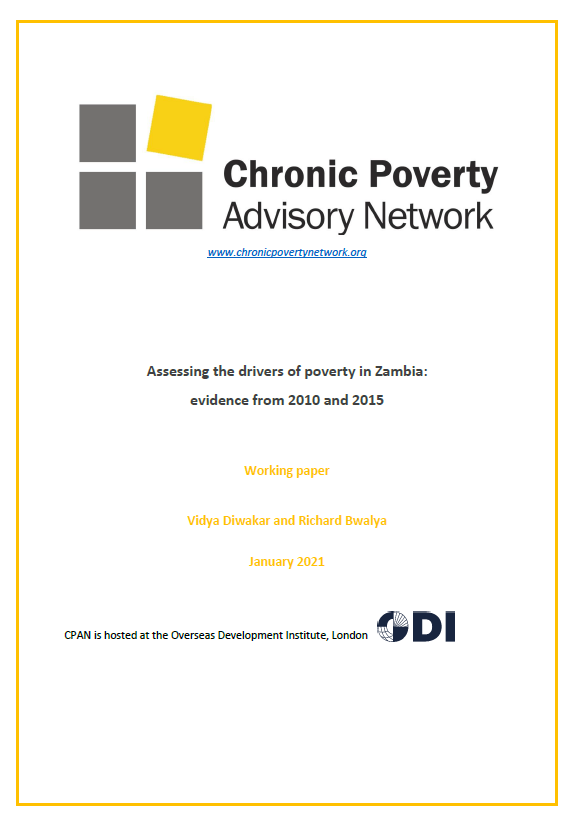Zambia remains a high-poverty country despite having attained middle-income status in 2011. According to projections, the country’s high levels of poverty will persist through to the middle of this century unless significant new policies and programmes can be developed. This report outlines the findings of a quantitative and qualitative analysis of poverty dynamics – defined as being stuck in poverty, escaping poverty either temporarily or in a sustained way, or becoming poor – and draws out policy implications.
Structural financial distress is manifested in the high levels of severe/food poverty, chronic poverty and impoverishment in rural areas witnessed by this study, which are strongly linked to environmental sustainability issues (deteriorating fish stocks, soil fertility, drought and floods) and disaster risk. There are many further effects: inability to cope with health shocks over time, early marriage, alcoholism, divorce, and a high number of chronically poor women-headed households. Panel data reveals relatively less poverty in urban areas compared to rural areas, but high levels of inequality within urban areas. Those in poorer urban townships endure high rents and the threat of eviction, precarious labour incomes and exploitation marked by long periods of unemployment. Inflation in the costs of living, together with the real costs of educating children, are not met by rising employment and incomes.
Sustained escapes are all too rare – where they occur, they are characterised by diversification within farming or into nonfarm enterprises, and by transitions from rural to urban residence. However, rural-urban migration as a pathway out of poverty is limited in Zambia compared to many other countries, indicating a need to spread the ‘inclusive urban development’ now being pioneered in Lusaka to other cities and towns across the country, in the hope that urban areas become more migrant-friendly. Impoverishment and temporary escapes from poverty are much more common in rural areas. A much greater emphasis in policy development is needed to prevent people falling (back) into poverty as well as to tackle the widespread rural chronic poverty. In urban areas, there is an urgent need to invest in the country’s power generation and electricity distribution system to avoid a repetition of the employment crisis generated by the 2019 drought and persistent load shedding. Load shedding has significant impacts on people’s livelihoods, especially traders, saloon and barber shop owners, welders and other users of electricity. Increasing the rate of rural electrification and access for poorer households will also help build resilience through investments in irrigation and nonfarm enterprises.
The overall context is one of macroeconomic vulnerability and constraints on public action. Zambia is a Least Developed Country (LDC) that is mineral-dependent, debt-distressed and with a revenue deficit. It also suffers from long-term urban–rural, inter-provincial and gender inequalities and highly contested politics characterised by weak policy development and implementation. With the advent of a new government, policies now need to tackle the causes of adverse poverty dynamics, and to introduce innovations into the policy framework – this research has suggestions on what they should be. Implementation problems are widespread, with examples including regularly delayed subsidised fertiliser distribution (despite early requests for down payments from beneficiaries), inadequate financing of social cash transfers and associated corruption scandals, and inadequate financing of the Food Security Pack programme. These contextual factors significantly constrain the effectiveness of state action on poverty reduction.
Zambians have faced a recent period of sharp shocks to the incomes of the poor (from 2017 to end-2019) as well as a decade (2011 to present) of systemic stressors driving a slower decline in income, savings and assets which increased the vulnerability to the recent shocks faced by households and those brought on by COVID-19 in 2020–21. The management of the 2019 drought is being evaluated, but the official response appears to have left much to be desired. Coupled with concerns about COVID-19 donor funding, questions are being raised about the politicisation of relief.
In this context, it is remarkable that some people can still escape poverty and remain out of it. The qualitative research revealed how these ‘sustained escapers’ demonstrate the benefits of education (including educated children), a stable marriage, women’s empowerment, diverse livelihoods, hard work, compassionate employer-labour relationships and careful management of health, partners, recreational pursuits and assets. In the medium term, getting agriculture policy right, combined with supporting diversification and inclusive urbanisation and supported by significant increases in public expenditure on health and education, will go a long way towards supporting those escapes and supporting more people to escape in the first place. With its 8th National Development Plan in process and a new government, Zambia has a major opportunity to tackle its persistently high poverty levels.
Authors: Andrew Shepherd, Virginia Bond, Chiti Bwalya, Richard Bwalya, Antony Chapoto, Lucia da Corta, Vidya Diwakar, Marta Eichsteller, Lwiindi Gwanu, Mary Lubungu, Monde Mwamba, Phillimon Ndubani, Joseph Simbaya and Mitelo Subakanya








